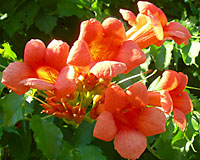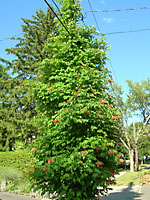Terry L. Ettinger Horticulture Consulting Services
Meeting The Needs Of Today With A Vision For The Future
Question of the Week
Trumpetvine Flower Frustration
 Q. I planted three hummingbird vines on a large fence almost ten years ago
and they've yet to bloom. On the advice of friends,
neighbors and family, I've variously fertilized them, cut them to the
ground, and pruned their roots by driving a spade into the ground a
foot from their trunks - all to no avail. Is there any chance that
I'll see their stunning orange flowers in my lifetime?
Q. I planted three hummingbird vines on a large fence almost ten years ago
and they've yet to bloom. On the advice of friends,
neighbors and family, I've variously fertilized them, cut them to the
ground, and pruned their roots by driving a spade into the ground a
foot from their trunks - all to no avail. Is there any chance that
I'll see their stunning orange flowers in my lifetime?
A. First, I'm pretty sure that you're referring to Trumpetcreeper? It's an incredibly rapid-growing vine that includes both a North American native species (Campsis radicans), a species native to the Korean peninsula (Campsis grandiflora) and their hybrids (Campsis x tagliabuana).
 In researching this response to your question, I came across an article published in the 1994 research conference
proceedings of the Southern Nursery Association that might shed some light on your frustration with these
house-eating vines, at left?
In researching this response to your question, I came across an article published in the 1994 research conference
proceedings of the Southern Nursery Association that might shed some light on your frustration with these
house-eating vines, at left?
Without getting into the nitty-gritty details, the article suggests that there are "adult" and "juvenile" forms of trumpetcreeper.
The adult forms generally flower within a couple of seasons of being planted in a landscape. Juvenile forms, on the other hand, may take five to ten or more years before producing their first flowers!
Because these forms look very similar to the untrained eye, nursery stock growers may be unaware that they're mixing stem cuttings of adult and juvenile forms of trumpetcreeper in their propagation beds.
While these cuttings look almost identical, those taken from adult forms apparently root slowly and in low percentages, while juvenile forms root quickly and in high percentages.
The end result is that growers may often, though unknowingly ship trumpetcreeper vines derived mostly from easy-to-propagate, but slow-to-flower juvenile forms.
Therefore, it may be that your vines are still maturing into plants capable of flowering, even after all these years?
The only thing you can do at this point to prune them very hard in late winter or early spring to established a framework of two or three main trunks and several long shoots/branches, or "arms" off of each trunk. All remaining, vine-like stems coming off of these arms should then be cut back to no more than two or three buds.
Repeating this hard pruning for several years will result in the formation of short, palm-like stem "spurs" along the arms from which shoots capable of forming flowers are more likely to emerge.